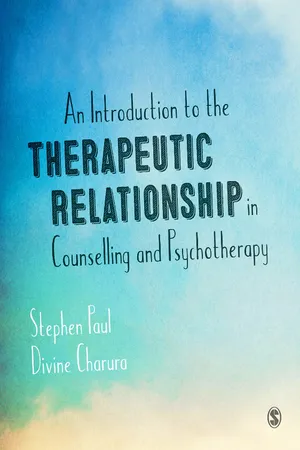
An Introduction to the Therapeutic Relationship in Counselling and Psychotherapy
- 304 pages
- English
- ePUB (mobile friendly)
- Available on iOS & Android
An Introduction to the Therapeutic Relationship in Counselling and Psychotherapy
About This Book
The therapeutic relationship is considered to be the most significant factor in achieving positive therapeutic change. As such, it is essential that trainee and practising therapists are able to facilitate a strong working alliance with each of their clients. This book will help them do just that, by offering a practical and evidence-based guide to all aspects of the therapeutic relationship in counselling and psychotherapy. Cross-modal in its approach, this book examines the issues impacting on the therapeutic relationship true to all models of practice.
Content covered includes: - The history of the therapeutic relationship
- The place of the therapeutic relationship in a range of therapy settings, including IAPT
- Concepts and practical skills essential for establishing and maintaining a successful working alliance
- The application of the therapeutic relationship to a variety of professional roles in health and social care
- Practice issues including potential challenges to the therapeutic relationship, working with diversity and personal and professional development
- Research and new developments
Using examples, points for reflection and chapter aims and summaries to help consolidate learning, the authors break down the complex and often daunting topic of the therapeutic relationship, making this essential reading for trainee and practising therapists, as well as those working in a wider range of health, social care and helping relationships.
Frequently asked questions
Information
Part I Introducing the Therapeutic Relationship
1 Introducing the therapeutic relationship
- The development of psychiatry, psychology and the talking therapies.
- The development of modalities and differing perspectives.
- The importance of the therapeutic relationship in counselling and psychotherapy.
Psychiatric and psychological foundations
Psychiatry
Practitioner Clip 1.1 Bars on the windows of the mind

Psychology

The four forces of psychology
Table of contents
- Cover
- Half Title
- Publisher Note
- Title Page
- Copyright Page
- Acknowledgements
- Contents
- About the Authors
- Acknowledgments
- Acronyms
- Introduction The therapeutic relationship in counselling and psychotherapy
- Part I Introducing the Therapeutic Relationship
- 1 Introducing the therapeutic relationship
- 2 What the research tells us
- 3 The relationship in different modalities
- 4 A relational approach to therapy
- 5 Developmental factors in a relational approach
- Part II Establishing and Maintaining the Relationship
- 6 Establishing the relationship
- 7 Developing the relationship
- 8 Challenges to the relationship: When things get tricky
- 9 Ending the relationship
- Part III The Relationship in Context
- 10 The therapist’s self in relationship
- 11 Working with difference within the therapeutic relationship: A relational perspective
- 12 Developing your practice: A relational perspective
- Glossary
- Appendix: Conclusions and Recommendations of the Interdivisional (APA Divisions 12 & 29) Task Force on Evidence-Based Therapy Relationships (John C. Norcross, PhD, Chair, 2 January 2011)
- References
- Index